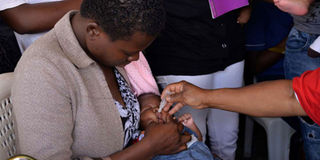Breaking News: KDF chopper crash kills five
Health workers' strikes expose children to diseases

A child gets a vaccine during a free medical camp at Makadara sports grounds in Nairobi on September 18, 2014. FILE | NATION MEDIA GROUP
What you need to know:
- The data further shows that more than 3,000 children in Kerugoya and Laikipia counties have not been fully immunised from January to June
- With Mandera being an arid and semi-arid county, health facilities have been facing challenges in accessing the vaccines
Children in various counties are missing out on vaccines against life threatening diseases such as measles, diphtheria and tetanus due to prolonged health workers’ strike.
In the affected counties, the vaccination levels are stagnating, with children from poor backgrounds at the highest risk.
A scorecard of immunisation performance for January to June 2019 from the Health ministry shows that 181,510 children have not been fully immunised.
The data further shows that more than 3,000 children in Kerugoya and Laikipia counties have not been fully immunised in the said period. Full immunisation refers to administration to children below one year of one dose of BCG, another of measles and three doses each of Oral Polio Vaccine and pentavalent, pneumococcal vaccines. A spot check in Kirinyaga County reveals that women travel from as far as Makutano and Sagana to Kerugoya Hospital in order to access vaccines for their children during the strike.
SHORT-STAFFED
Ruth Wamuyu is one such woman. She says she travelled with three-month-old daughter to the hospital because she could not get the services in the clinic she frequents. “I did not find health workers at the clinic, so I just decided to come here,” she says.
Unlike her, some mothers do not go to such lengths and, instead, have decided to wait until the strike is over to get their children vaccinated which affects immunisation coverage in the region.
As the rest of the country gears towards recovering from low immunisation coverage, counties like Kirinyaga end up contributing to the decline in standards.
The county, which had 100 per cent coverage in the beginning of the year, has registered a 30 per cent drop, with 2,101 children not fully immunised.
Laikipia is also fast catching up with Kirinyaga. At 83 per cent coverage, 1,533 children have not been immunised in the county. This is a decline from 86 per cent at the beginning of the year.
POOR DOCUMENTATION
During a visit to the county, some facilities admitted that few women came in to have their children immunised.
A health worker at the Nanyuki Teaching and Referral Hospital, who wanted to remain anonymous, said they have been short-staffed.
“We see very few women walk through these doors because most are not even aware that we are back and that the services are available,” she said.
Of great concern from the Health ministry’s data, however, is Mandera County where 11,604 children have not been vaccinated. Health workers went on strike early this month, but which was resolved within a week.
However, with Mandera being an arid and semi-arid county, health facilities have been facing challenges in accessing the vaccines. Poor documentation and supply chain challenges have led to occasional stockouts.
The immunisation levels going down means that if the children fall ill, they are at risk of the most severe health consequences and are least able to get treatments and care needed. The government already played catch up on the vaccination exercise after 2017.



